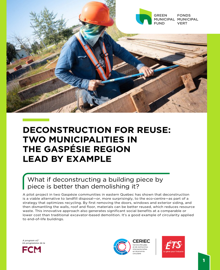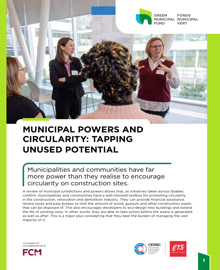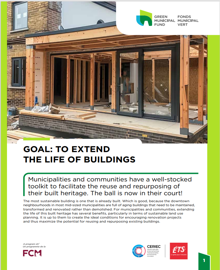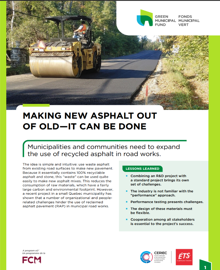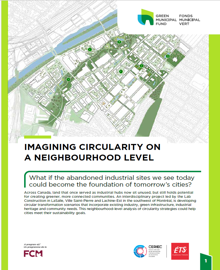The construction sector generates over 40% of global greenhouse gas emissions. In Quebec, it produces more than 3.3 million tonnes of CRD waste each year, of which only 25% are actually recycled. Transitioning to a circular economy requires rethinking production and consumption models while optimizing existing resources to address climate and resource challenges.
To tackle these issues, the Centre d’études et de recherches intersectorielles en économie circulaire (CERIEC) develops innovative circular strategies to reduce waste and improve sustainability in the construction sector. CERIEC launched the Lab Construction, a three-year research and innovation initiative (2021–2024), delivering 19 projects through co-creation and field experimentation. These projects provide practical tools, share knowledge and create real-world solutions that enhance Quebec’s construction landscape.
This factsheet page offers resources to help municipalities, industry professionals and policymakers adopt circular construction practices. These insights highlight the environmental, economic and social benefits of circularity, including waste reduction, lower greenhouse gas emissions and optimized resource use. If you want to integrate sustainable practices into your construction projects, our resources will equip you with the knowledge and tools to take action.
Deconstruction for reuse: Municipalities in the Gaspésie region lead by example
Municipalities have a unique opportunity to reduce construction, renovation and demolition waste, which significantly contributes to landfill overflow and greenhouse gas emissions. By embracing strategic deconstruction initiatives such as salvaging wood, metal and concrete, communities can recover valuable materials with cost-effective solutions and advance sustainability goals.
A pilot project in two Gaspésie communities—Grande-Rivière and Chandler in eastern Quebec—showcases how municipalities can successfully apply circular economy principles to end-of-life buildings. By prioritizing material reuse, these communities have cut waste, generated revenue and inspired broader adoption of deconstruction practices.
The Federation of Canadian Municipalities (FCM) has also contributed to the project, reinforcing its commitment to supporting initiatives that promote sustainable development in Canadian communities.
Why choose deconstruction?
- Reduce landfill waste and extend material lifespan
- Cut emissions by minimizing transportation and new material production
- Save money through material resale and reduced disposal fees
- Boost local economies by creating jobs in sustainable construction
The factsheet above offers municipalities step-by-step strategies to integrate deconstruction into their building projects. Learn how to plan material recovery, train contractors and implement policies that support long-term sustainability.
Download the factsheet and start transforming waste into opportunity.
Municipal powers and circularity: Tapping unused potential
Municipalities play a key role in driving circularity within the construction, renovation and demolition sector by reducing waste and conserving resources while strengthening community resilience. For example, they can use regulatory tools to promote material reuse, waste diversion and sustainable building practices to ensure a more efficient and eco-friendly development process.
This factsheet helps Canadian municipalities harness their policy levers to advance circular economy practices. It highlights the benefits of these powers, outlines actionable steps for immediate implementation, and showcases real-world examples of successful initiatives. By adopting these strategies, municipalities can cut landfill waste and build a sustainable future.
Goal: To extend the life of buildings
Canadian municipalities are rethinking urban development by prioritizing adaptive reuse over demolition. For example, authorities in Trois-Rivières, Quebec issued renovation permits for minor work in 82% of their projects—demonstrating that communities already invest in reuse. However, outdated policies, financial constraints and misconceptions often push demolition to the forefront.
Reusing and repurposing existing buildings preserves heritage and drives sustainable development. Municipalities reduce construction waste, lower emissions and strengthen community resilience by choosing adaptive reuse. Research from Entremise and Université Laval shows that updating policies, streamlining permit processes and offering financial incentives can make reuse the default option.
This factsheet equips municipalities with practical strategies to:
- Recognize the economic, environmental and cultural benefits of adaptive reuse
- Identify barriers and misconceptions about reuse and financial feasibility
- Implement successful municipal policies that support reuse Engage communities in redevelopment projects
- Assess the economic and environmental impacts of demolition versus reuse
Municipalities can cut costs, reduce waste and breathe new life into communities by making reuse the norm.
Making new asphalt out of old—It can be done
Discover how Canadian municipalities can transform existing roads into sustainable infrastructure with reclaimed asphalt pavement (RAP). By repurposing old asphalt, municipalities can reduce waste and emissions, cut costs, rely less on newly extracted materials, and advance circular infrastructure goals.
This factsheet highlights key lessons from a pilot project in Saint-Hippolyte, Quebec, and provides practical steps for integrating RAP into municipal roadwork projects. Whether you’re a municipal engineer, policymaker or sustainability advocate, this resource can help empower you to take action.
Read the factsheet and help drive circular economy solutions.
Imagining circularity at the neighbourhood level
What if yesterday’s factories and forgotten lots could become the foundation of tomorrow’s most sustainable communities?
Across Canada, post-industrial lands sit idle—contaminated, underused and disconnected. But these places hold extraordinary potential. With the right vision and strategy, municipalities can breathe new life into these sites, turning them into neighbourhoods that are climate-resilient, economically vibrant and socially inclusive.
In Montréal’s southwest boroughs, a team of designers, engineers and researchers collaborated to reimagine underused areas. They prioritized the reuse of existing structures, integrated green infrastructure and created pathways for community involvement offering a scalable model for municipalities across Canada.
Why embrace circular neighbourhood planning?
- Reuse before you rebuild: Save money and reduce carbon by adapting existing structures
- Design with intention: Use life cycle analysis (LCA) to guide low-impact development
- Build climate-ready communities: Integrate green infrastructure and clean energy solutions
- Engage communities in the process: Use collaborative approaches that prioritize local voices
- Lead with policy: Activate policy levers that empower municipalities to drive circular change
The factsheet highlights a real-world pilot in LaSalle, Ville Saint-Pierre, and Lachine-Est that explores how to move from theory to action, from neglected to reimagined. Whether you’re leading planning efforts, shaping policy, or looking for inspiration, this is your blueprint for action.
Read the factsheet and start reimagining your municipality's future.
Featured resources
Guide: Taking your indoor ice rink to net zero
Learn how to develop an actionable roadmap to net zero ice rinks
Read moreGuide: Taking your indoor swimming pool to net zero
Key measures and lessons learned to help you build a net-zero plan
Read moreGuides: Equity and non-energy benefits of community building retrofits
Explore how retrofits can build more equitable and resilient municipalities.
Read more

